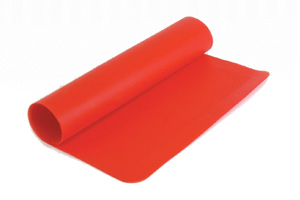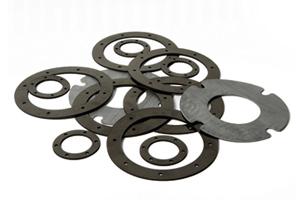ACE- ALPHA Rubber is the most cost-effective material to use where temperatures and pressures are low and the chemical environment is mild.
Different elastomers offer different mechanical and chemical properties. Cloth inserted materials are better able to handle movement and high compression loads.
Ace- alpha rubber gaskets that can be die cut or CNC flash cut from a variety of rubber materials.
Typically used in piping and plumbing applications, our rubber gaskets offer excellent resilience and sealing for applications involving low temperatures and pressures and mild chemical environments.


| Material | Temp. (F) | P Max (psi) | Thick. (in.) | Applications/Features |
|---|---|---|---|---|
| Neoprene (Chloroprene) | -40 to 225 | 150 | 1/16 to 1/4 | Gases, inorganic acids & alkalis. Excellent weather/abrasion resistance. |
| EPDM | -40 to 212 | 150 | 1/16 to 1/4 | Water, steam, animal/vegetable oils, oxygenated solvents. Excellent weather resistance. |
| SBR | -20 to 140 | 100 | 1/32 to 1 | Acids, organic salts & alkalis. Non-toxic. Abrasion resistant. Soft. |
| Silicone | -20 to 170 | 150 | 1/32 to 1/4 | Oil/gasoline. Excellent weather resistance. Handles movement. High tensile strength. |
| Nitrile (NBR, Buna-N) | -25 to 170 | 150 | 1/32 to 2 | Oil/Aromatic fuels, mineral, animal and vegetable oils, solvents and hydraulic fluid. Available in commercial, premium and FDA grades. |
| Silicone | to 400 | 150 | 1/32 to 1/4 | High temperature air or water (not oil or steam). Soft. Available in FDA grade. |
| Viton® | to 400 | 150 | 1/32 to 1/4 | Oil/Aromatic fuels, mineral, animal and vegetable oils, solvents and hydraulic fluid. |
| Available with Cloth insert & steel reinforcement | ||||
Neoprene has good resistance to oils, sunlight and aging. Temperature range is -40˚F to +230˚F, intermittent to +250˚F. Resistance to compression set is good. Chemical resistance to silicone oil and grease, refrigerants, ammonia and carbon dioxide. Also available as per drawings and specification.
EPDM combines excellent resistance to deteriorative effects of ozone, oxygen, weather, heat and many chemicals. Its serviceable temperature range is -40˚F to +250˚F and intermittent to +275˚F. It is not recommended for use in contact with petroleum oils or fluids. Also available as per drawings and specification.
SBR is a copolymer of styrene and butadiene and has properties similar to natural rubber. It has greater abrasion resistance than natural rubber, better wear resistance and better low temperature flexibility. Though superior in water resistance to natural rubber, it has about the same resistance to solvents and chemicals. It has better heat resistance and heat aging qualities than natural rubber, and in excess heat it hardens and becomes brittle instead of softening as does natural rubber. Resistance to sunlight and ozone is similar to natural rubber. The temperature range of SBR is -55˚C to +70˚C (-67˚F to +158˚F). SBR rubber is available in sheet material. Also available as per drawings and specification.
Silicone retains good elastomeric properties at both low and high temperatures. Should not be exposed to fuels, solvents or silicone fluids. Silicone has excellent resistance to ozone, aging and weather. Serviceable temperature range from -67˚F to +400˚F, intermittent to +450˚F. Also available as per drawings and specification.
Has excellent resistance to petroleum oils and gasolines. Resistance to aliphatic hydrocarbons, acids and bases is good. The temperature range is -40˚F to +212˚F, intermittent to +230˚F. Excellent resistance to permanent compression. It does not possess good resistance to ozone, sunlight or weather. Also available as per drawings and specification.
Viton® has excellent resistance to high temperatures, ozone, oxygen, fuels, mineral oil and synthetic hydraulic fluids. Maximum operating temperatures run from 400˚F in continuous service up to 500˚F in intermittent service. Also available as per drawings and specification.
Natural rubber has high resilience, good tensile strength and good tear resistance. It does not perform well when exposed to chemicals and petroleum derivatives. Natural rubber is inferior to many of the synthetics in heat aging, resistance to sunlight, oxygen, ozone, solvents and oils. The temperature range is -55˚C to +55˚C (-67˚F to +122˚F).